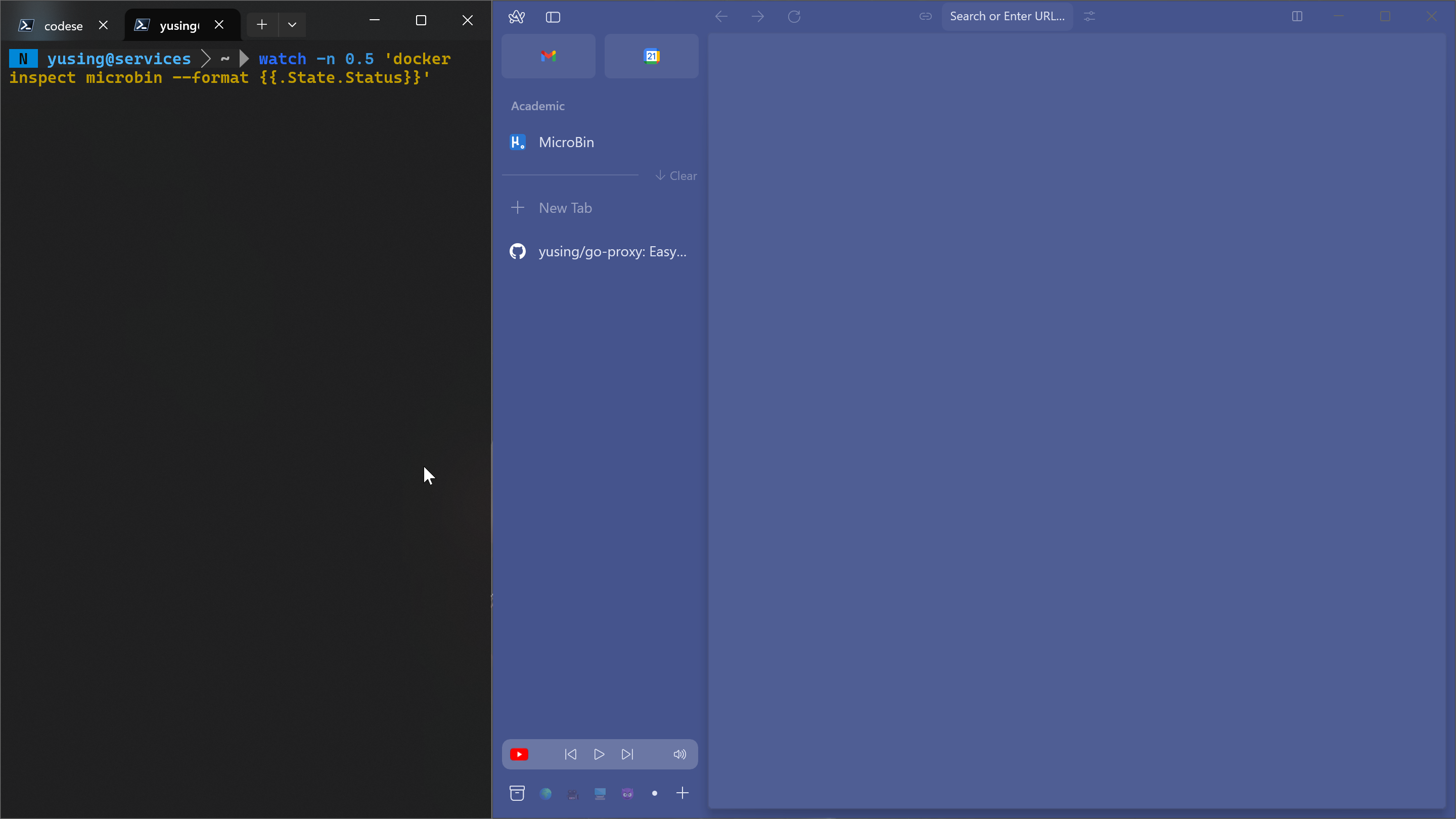| .github/workflows | ||
| .vscode | ||
| docs | ||
| examples | ||
| schema | ||
| showcase | ||
| src | ||
| .gitignore | ||
| .gitlab-ci.yml | ||
| .gitmodules | ||
| compose.example.yml | ||
| config.example.yml | ||
| Dockerfile | ||
| go.work | ||
| LICENSE | ||
| Makefile | ||
| providers.example.yml | ||
| README.md | ||
| README_CHT.md | ||
go-proxy
A lightweight, easy-to-use, and performant reverse proxy with a web UI.
Table of content
Key Points
- Easy to use
- Effortless configuration
- Simple multi-node setup
- Error messages is clear and detailed, easy troubleshooting
- Auto SSL cert management (See Supported DNS Challenge Providers)
- Auto configuration for docker containers
- Auto hot-reload on container state / config file changes
- idlesleeper: stop containers on idle, wake it up on traffic (optional, see showcase)
- HTTP(s) reserve proxy
- TCP and UDP port forwarding
- Web UI for configuration and monitoring (See screenshots)
- Supports linux/amd64, linux/arm64, linux/arm/v7, linux/arm/v6 multi-platform
- Written in Go
Getting Started
Setup
-
Pull docker image
docker pull ghcr.io/yusing/go-proxy:latest -
Create new directory,
cdinto it, then run setupdocker run --rm -v .:/setup ghcr.io/yusing/go-proxy /app/go-proxy setup -
Setup DNS Records point to machine which runs
go-proxy, e.g.- A Record:
*.y.z->10.0.10.1 - AAAA Record:
*.y.z->::ffff:a00:a01
- A Record:
-
Setup
docker-socket-proxyother docker nodes (if any) (see example) and then them insideconfig.yml -
Done. You may now do some extra configuration
- With text editor (e.g. Visual Studio Code)
- With Web UI via
gp.y.z - For more info, See docker.md
Commands line arguments
| Argument | Description | Example |
|---|---|---|
| empty | start proxy server | |
validate |
validate config and exit | |
reload |
trigger a force reload of config | |
ls-config |
list config and exit | go-proxy ls-config | jq |
ls-route |
list proxy entries and exit | go-proxy ls-route | jq |
run with docker exec go-proxy /app/go-proxy <command>
Environment variables
| Environment Variable | Description | Default | Values |
|---|---|---|---|
GOPROXY_NO_SCHEMA_VALIDATION |
disable schema validation | false |
boolean |
GOPROXY_DEBUG |
enable debug behaviors | false |
boolean |
GOPROXY_HTTP_ADDR |
http server listening address | :80 |
[host]:port |
GOPROXY_HTTPS_ADDR |
https server listening address (if enabled) | :443 |
[host]:port |
GOPROXY_API_ADDR |
api server listening address | 127.0.0.1:8888 |
[host]:port |
Use JSON Schema in VSCode
Copy .vscode/settings.example.json to .vscode/settings.json and modify it to fit your needs
Config File
See config.example.yml for more
# autocert configuration
autocert:
email: # ACME Email
domains: # a list of domains for cert registration
provider: # DNS Challenge provider
options: # provider specific options
- ...
# reverse proxy providers configuration
providers:
include:
- providers.yml
- other_file_1.yml
- ...
docker:
local: $DOCKER_HOST
remote-1: tcp://10.0.2.1:2375
remote-2: ssh://root:1234@10.0.2.2
Include Files
These are files that include standalone proxy entries
See Fields
See providers.example.yml for examples
Showcase
idlesleeper
Build it yourself
-
Clone the repository
git clone https://github.com/yusing/go-proxy --depth=1 -
Install / Upgrade go (>=1.22) and
makeif not already -
Clear cache if you have built this before (go < 1.22) with
go clean -cache -
get dependencies with
make get -
build binary with
make build
